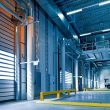Lifts have transcended being mere vertical transportation tools; they have evolved into indispensable components of our daily lives. Their significance spans across personal and commercial settings, with commercial elevators playing a pivotal role in enhancing mobility for both people and goods within commercial setups. Distinct from their residential counterparts, commercial lifts exhibit variations in size, efficiency, cost, and usage. They find their home in establishments such as hotels, shopping centres, and office blocks. The selection of the right commercial lift is crucial, as it can significantly impact the operations of a business or organisation when service issues or interruptions occur.
The Diverse World of Commercial Elevators
1.Traction Lifts: Elevating Efficiency Traction lifts are premium, robust elevators primarily intended for ferrying passengers in commercial environments. Renowned for their exceptional efficiency, these elevators consume less power while delivering higher speed and superior performance compared to hydraulic lifts. Traction lifts are capable of carryingvarying loads, ranging from 320kgs to 2000kgs, offering both gearless and geared machine options. They operate smoothly and quietly, ensuring a comfortable ride for passengers.
2.Goods Lifts: Powering Productivity Goods lifts are engineered to effortlessly transport goods across various working environments with utmost ease and performance. They reduce the risk of injuries associated with manual lifting, making them invaluable assets for industries and factories. These lifts, featuring a low pit design, can be seamlessly installed in existing buildings.
The category includes:
3.Low Pit Lifts: Practical and Cost-Effective Low pit lifts closely resemble passenger lifts but operate at reduced speeds and boast shallow pits. These features make them popular choices for commercial spaces requiring minimal pit depth for installation. These lifts are not only cost-effective but also commonly found in settings like offices, schools, and retail stores.
4.Freight Elevators: Heavy-Duty Transport Freight elevators are designed specifically for the transportation of goods or freight, capable of handling substantial loads. These elevators are built to withstand the wear and tear associated with loading and unloading operations.
5.Hydraulic Lifts: Simplicity and Affordability Hydraulic lifts are known for their simplicity, utilising hydraulic pressure generated by an electric motor to elevate the cab. When descent is required, hydraulic liquid or oil is released through a valve. Typically used in buildings with up to five floors, these lifts offer a cost-effective solution with lower maintenance expenses compared to other elevator types.
6.Screw Driven Lifts: Efficiency and Ease Screw driven lifts employ screw and nut technology (SN), providing efficiency and easy installation. The cab is linked to the drive nut, controlled by a motor. These lifts find applications in both commercial and residential settings.
7.MRL Lifts: Compact and Convenient Machine room less lifts (MRL lifts) incorporate a control room positioned adjacent to the elevator, eliminating the need for a dedicated machine room. Maintenance is akin to that of traction lifts, and these elevators can achieve impressive speeds, making them popular choices for mid-rise buildings up to 250 ft in height.
8.Wheelchair Lifts: Inclusivity in Motion Wheelchair lifts cater to individuals with mobility challenges, offering open lifts for transportation within a few floors.
9.Industrial Elevators: Heavyweight Champions Industrial elevators are indispensable in industries and factories for lifting heavy loads. They typically come in the form of hoist and incline elevators, serving warehouses, shipyards, and construction sites.
The Legal Imperative
By law, commercial properties, multi-level buildings, and office spaces are obligated to install commercial lifts. Depending on your specific requirements, you can choose from a wide array of options to meet your needs. Hi-Lift Elevator stands as a high-performance elevator provider, specialising in both commercial and industrial lifts. Hi-Lift Elevator aligns with design and specification guidelines, boasting a team of professionals ready to guide you in selecting the ideal commercial lift to suit your requirements. From purchase to installation, Hi-Lift Elevator provides end-to-end service, including customisation of parts to accommodate specific project needs. The company also prioritises passenger safety with standard secure systems.
The world of commercial elevators offers a diverse range of options, each tailored to meet specific needs. Whether you’re looking to enhance passenger mobility or streamline the transportation of goods, choosing the right commercial elevator is pivotal in ensuring smooth operations and compliance with legal requirements. Hi-Lift Elevator, with its expertise and dedication to safety, stands as a reliable partner in this endeavour.










